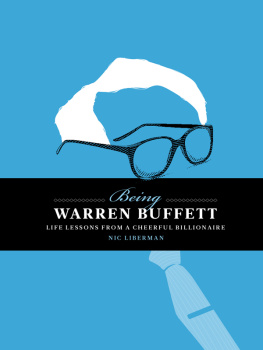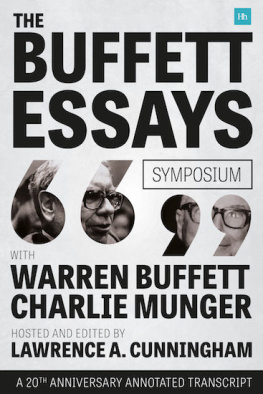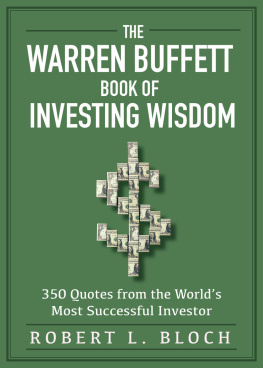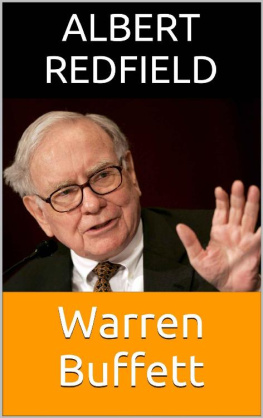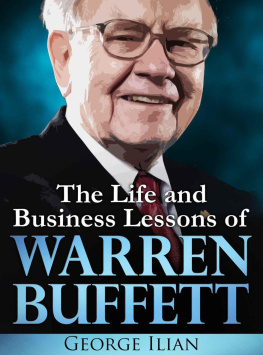ROBERT G. HAGSTROM
ROBERT G. HAGSTROM




FOREWORD
Investing is context dependent. The best investment advice is general and timeless, but not very helpful if you have to figure out what to do today. "Buy low, sell high" is advice that works in all investing environments. It doesn't matter if it's the twenty-first century and you're Warren Buffett buying junk bonds, or the nineteenth century and you're a Rothschild taking advantage of the panic surrounding Waterloo, or 500 B.C. and you're the pre-Socratic philosopher Thales of Miletus, making his fortune in commodity markets. The trouble with that advice, though, is that if you know what's low and what's high, you don't need it. If you don't know, you don't need it either, since you won't be able to use it.
The more specific the advice, the more its use depends on the current environment and how it evolves. The answer to almost every investment question is the same: It depends. Are technology stocks a good investment? They were from 1996 through 1999, but in 2000 they had their biggest yearly decline in history.
Are stocks a better long-term investment than bonds? It depends. Does your long term start in the late 1920s and end in the late 1940s? Then the answer is "no." Or does it start in the late 1940s and end in the late 1960s? In that case, the answer is "of course." The amount of time is the same; the result is totally different. When the answer is "it depends," the question is context dependent.
Context dependence is why so much investment writing is useless after a few weeks. The more specific the advice, the quicker it becomes dated. No one reads last year's investment "strategy" pieces from the major Wall Street firms to get insight about what to do. The demand for investment books is context dependent, too. Books about monetary crises dominated the bestseller lists in the early to mid-1970s, inflation titles were the rage in the early 1980s, and books about the Internet just finished their brief flurry of fame.
The list of perennially useful investment books is short. Reminiscences of a Stock Operator is a book most professional investors and nearly every successful trader has read and found worthwhile. It is the thinly veiled story of legendary stock operator Jesse Livermore, told in his own words and transcribed by Edwin Lefevre, who is listed as the author. Its value lies in its descriptions of situations that recur in every investment era, and the strategies Livermore used to deal with them. He became adept at recognizing recurring patterns and profiting from them. He was not so adept at recognizing that superficially similar patterns can turn out to be substantially different. He made and lost several fortunes; the last loss led him to shooting himself in the men's room of the Sherry Netherland hotel.
Another fine investment book is known more by its title than its contents. Where Are the Customers' Yachts? by Fred Shwed is interesting as a period piece-an amusing picture of a mostly vanished world.
The rarest investment books are those that can be profitably read by everyone interested in the craft of investing: books that inform, illuminate, and teach, that can be reread in different periods and contexts and that will deepen our understanding or provide new insights into the current situation.
For value investors, one classic is Ben Graham's The Intelligent Investor. First published in the late 1940s, it reflects Security Analysis, his pioneering text, without the heavy lifting. You can be a good investor and never have read The Intelligent Investor, but you'll be a better one if you have. Graham inspired and shaped the thinking of a generation of value investors, the best known, of course, being Warren Buffett.
I first became aware of Warren Buffett in the mid-1970s through Adam Smith's now out of print Super Money, the sequel to his best-selling tale of the late 1960s bull market, The Money Game. Written after the severe declines of 1969 and 1970 and the bankruptcy of the Penn Central Railroad, Super Money introduced Buffett in Chapter 5, titled "Somebody Must Have Done Something Right: The Lessons of the Master." The chapter was about Graham's principles of margin of safety and intrinsic value, illustrated through the activities of Warren Buffett, then in his early forties and comfortably rich. Unlike the famous fund managers of the 1960s such as Fred Carr, Fred Mates, and Gerry Tsai, Buffett avoided the collapse, disbanding his partnership when speculative excess removed the margin of safety he deemed necessary to continue investing in public markets.
I was then in my mid-twenties and what immediately got my attention was that Buffett's initial capital rounded to zero, but when he ended the partnership at 39 he had $25 million. The way "Adam Smith" told it, Buffett got some money from friends and family, and "sat in his bedroom office, reading through the manuals..." He bought "quiet simple stocks, easy to understand, with a lot of time left over for the kids, for handball, for listening to the tall corn grow." Having an almost infinite capacity for indolence, I thought this sounded pretty good. Start with nothing, read some stuff, buy a few stocks, wait, get rich, and then hang it up before 40.
I read Ben Graham and began looking around for stuff on Buffett. I got some money from friends and began buying stocks, simple, easy-to-understand companies trading at low price-earnings multiples, preferably with lots of hard assets and a good current ratio. I looked for net/nets, just as Graham advised. It was a little more work than the method Nicholas Darvas advocated in Haw I 'Made $2,000,000 in the Stock Market, which involved drawing boxes around the pattern of price action of a stock, as I recall, but I figured if it was too easy then others might get the excess returns before I did.
I need not have worried. Twenty-five years later, it seems people are just as eager to avoid thinking about the businesses underlying the stocks they buy as they ever were. Markets behave pretty much as they have since the time of Thales. Most people prefer to buy what is going up rather than what will go up. Peter Lynch has often said people will do more research on a $1,000 purchase of a refrigerator than they will before they spend $10,000 on a stock.
Today's markets are larger, deeper, offer more investment choices, move more quickly, and are accompanied by much more noise than the markets of the past. Markets have become democratized; more people own stocks than ever before, and governments cannot ignore markets as they once thought they could.
Markets are all about value. Their function is to price assets and, despite their shortcomings, no better system has been devised. Value is rarely overlooked for long. That is true in the market for books, as well as in the market for stocks.
I have always been mystified by the desire to write books. If you are unknown to the public, writing must surely have among the lowest probabilities of achieving an adequate economic return of any activity. We are fortunate that Robert Hagstrom writes books the way I eat cottage fries at the Post House in New York: compulsively. His compulsion, unlike mine, is good for you.


